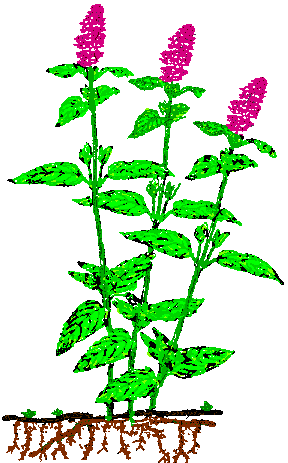
Computer Software
Publication CS195
Leonard Coop, Ralph Berry,
Glenn Fisher, Marcos Kogan

Computer Software
Publication CS195
Leonard Coop, Ralph Berry,
Glenn Fisher, Marcos Kogan

Background
About IPMP
Hardware Requirements
How to order
Approximately 89% of current U.S. peppermint oil production is from the Pacific Northwest, including Oregon, Pacific Northwest, including Oregon, Washington, and Idaho. Peppermint is host to a large complex of arthropods, both harmful and beneficials, in this region. An integrated management approach depends upon good information on the biology of pests and beneficials as well as a set of workable management practices.
Sound management requires the ability to forecast or predict pest timing and impact based on up-to-date weather and economic conditions. Both accumulated and dynamic information of these types have been integrated into a computer software package, known as Integrated Pest Management on Peppermint (IMP).
The IPMP program is intended to assist mint growers, consultants, and others with decisions on how best to manage insects and mites on mint. IPMP is designed to provide information on: 1) identification of the major pest and beneficial species in mint, 2) life cycles and habits, 3) sampling and monitoring, 4) treatment thresholds, and 5) management and control tactics. IPMP includes information on foliage feeding insects and mites including variegated cutworm and other cutworms/armyworms, loopers, aphids, and spider mites, and on the major root and rhizome feeding pests such as mint root borer, strawberry root weevil, mint flea beetle, redbacked cutworm, mint stem borer, wireworms, and symphylans. More detailed information on management of these and other pests on mint is contained in the 1993 publication: A Guide to Peppermint Insect and Mite Identification and Management, which is available from the publication offices either at Oregon State University in Corvallis or at Washington State University in Pullman.
Correct pest management decisions depend on an understanding of many related factors, including: 1) stage(s) of the pests, 2) their density and distribution in the field, 3) presence or absence of beneficial insects and mites, 4) occurrence of other pests such as plant diseases, nematodes, and weeds, 5) the stage and health of the crop, and 6) the alternatives available to control the pest(s), if and when necessary.
In mint, proper management of insects and mites is based on the following approaches: 1) planting pest-free root stock, 2) correctly identifying pests and beneficials, 3) sampling and monitoring pests and beneficials, 4) protecting beneficial insects and mites, 5) employing cultural practices when possible, such as flaming, tillage, and crop rotation, and 6) using insecticides as a last resort, and only when necessary based on treatment thresholds.
Pest management begins with accurate identification of insects and mites. Incorrect identification can result in the needless use of an insecticide and destruction of beneficial predators and parasites. Mint fields must be inspected on a regular basis to establish population trends and to determine whether or not control is necessary. The use of treatment thresholds will reduce the unnecessary use of insecticides, which will save money, protect natural predators and parasites and delay the development of insecticide resistance. Natural parasites and predators may be sufficiently abundant in some mint fields to suppress pest populations without the use of insecticides or miticides. This guide was prepared to help individuals accurately identify and sample mint pests and beneficial insects and mites, and to develop sound pest management decisions based on treatment thresholds. It emphasizes insects and mites on peppermint, but several of the same pests and beneficial insects and mites also occur on spearmint. Identification of pests and sampling procedures are similar in peppermint and spearmint, but additional research is needed to develop treatment thresholds for pests on spearmint.

IPMP is a Microsoft Window ®-based decision support system. It incorporates the latest in formation that can be aid in making informed decisions to management insect, mite, and soil arthropod pests of peppermint. The system utilizes " Window ® Help" technology to link text, research and extension articles, graphics, models, and sampling programs. More information is available for certain pests than for others, as reflected n different options among the 14 pests included in the program.
A total of 37 published reference articles have been scanned and linked to program text, allowing the user to explore a wide range of topics in great detail. Text files provide identification support, life cycles, sampling and control information.
Graphics are 256 color scanned photo-graphs of immature and mature life stages of pests and beneficials. A key to symptoms of both foliar and below ground injury is used to aid in identification of pest species. Phenology models can be updated current weather data and used to forecast the occurrence and management of life stages for four species: mint flea beetle, strawberry root weevil, variegated cutworm, and mint root bore. Sequential sampling plans provide up-to date economic injury level calculations and treatment decision support for strawberry root weevil, redbacked cutworm, and twospotted spider mites. There is a crop loss model or variegated cutworm, with component for sampling, crop loss simulation, and economic threshold determination.

Any computer that runs Microsoft Windows ® 3.1 should work with IPMP. Requirements include the following:
- IBM 386/486 compatible
- 4 megabytes RAM
- Mouse
- 3.5" 1.4 MB floppy drive
- 18 MB hard disk space free 11 MB excluding the demonstration files
- VGA video adapter (super VGA/256 colors required for best results

The IPMP 2.0 for Windows ®, CS195, is available for $29.00 per copy. Send check, money order or purchase order ( payable to Integrated Plant Protection Center ) to:
IPMP 2.0
IPPC Oregon State University
Cordley Hall 2040
Corvallis, OR 97331-2915
Tel: (503) 737 -3541
Fax: (503) 737-3080
Name _____________________________
Address ___________________________
Cit _______________________________
State ________ zip______________
Phone __________________________
Send me ____ copes of CS195,
IPMP 2.0 for Windows,
Total enclosed order $_____


 Integrated Plant Protection Center
Integrated Plant Protection Center
